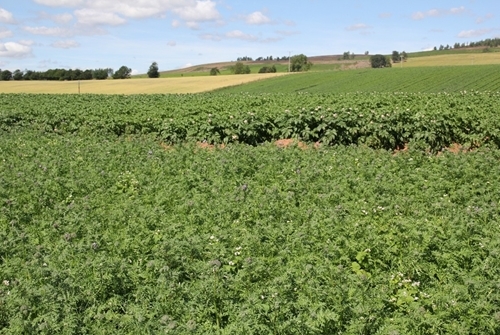Written by Fiona Torrance, Farmland Biodiversity Advisory GWCT Scotland and PepsiCo FAB Project Manager
One aim of the PepsiCo FAB project is to enhance communication between project participants. Over the course of the project, this has been done in a number of ways including regular updates, building relationships and providing project-related training events. One of the most popular activities the group undertake is attending farm walks at the participating farms, allowing farmers and partners the opportunity to learn about measures for nature, how challenges can be overcome and how farmers manage these features within their farming systems.
 The project team alongside Balnamoon’s Wild Bird Seed Mix © Eric Anderson
The project team alongside Balnamoon’s Wild Bird Seed Mix © Eric Anderson
The latest farm walk was held at Balnamoon Farm, located near Brechin in Angus. The morning started off with a session from NatureScot on the FarmBioScot app. This tool has been designed to help farmers both map and assess their own habitats, with supplementary advice given on how their habitats can be improved. The FAB project has been helping to test this new technology since 2023, and it was great to see how far it has come along. Further testing has been completed during 2025, and a summary of the testing results will be provided shortly.
Following this, the team were able to get out and see some of what the farm has to offer. At Balnamoon the farmer has chosen to establish the Balgonie Grey Partridge Mix as part of the FAB project. During the morning the team visited the first wild bird seed mix plot that was sown here in 2024 and it did not disappoint! From the moment we arrived we could both see and hear that the mix was alive with wildlife, demonstrating how valuable these multi-year mixes can be for biodiversity. The farmer has been equally pleased with it, to the extent that he has chosen to sow an additional area elsewhere, demonstrating how habitats like these can work for the farmer and wildlife alike.

The Balgonie Grey Partridge Mix © Fiona Torrance
Discussion inevitably turned to how features such as these should be managed. Although these mixes can be left in situ for 2-3 years, they generally require some management to provide additional diversity for farmland wildlife. This may include resowing, topping or perhaps even relocating the mix if it has not establish as expected. Each plot should be visited annually in Jan/Feb and reviewed.

Pollinator alongside potatoes © Eric Anderson
The group were also given the opportunity to see a pollinator mix that had been sown around the potatoes. This mix, including species such as phacelia, buckwheat and linseed, provides excellent food resources for insects (and their predators) during the summer months and are an excellent way of utilising field edges. They can also be effective for helping wildlife to move around the landscape, allowing species such as brown hare, grey partridge and other species to disperse.
Overall, attendees had a great morning and were treated to some spectacular habitats. We look forward to the next one!